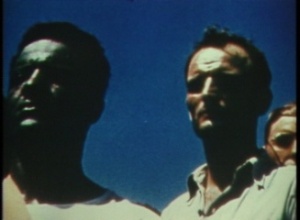The Iwo Jima Flag Raising
“- where uncommon valor was a common virtue.” Franklin D. Roosevelt, speaking on the Battle of Iwo Jima.
Today, February 23, 2010, marks the 65th anniversary of the raising of the United States flag on the Island of Iwo Jima. This video was taken from the documentary movie “To the Shores of Iwo Jima”. This is authentic footage that was photographed by US Navy and Marine Corps personnel during the actual battle. The motion has been slowed down and the famous Joe Rosenthal photograph, “Raising the Flag on Iwo Jima” superimposed at nearly the instant it was taken.
However, Rosenthal’s photograph was taken of a second flag raising, not the first one. Another photographer, Louis R. Lowrey took an equally iconic photograph of the first flag raising, but the Lowrey photograph got delayed in its processing. Then, when the Rosenthal photograph was released to the public, the Marine Corps got several names transposed from the first flag detail to the second one which was used as the caption in the newspapers. This mistake took several years and an official investigation to get corrected. Not much was known of the first flag raising for many years. Today, both flag raising details and both photographs are given equal credit by the Marine Corps and academic historians. In the right side of the movie frame, men from the first flag detail can be seen as well as a brief glimpse of the first flag’s stanchion.
The movie footage was photographed by Marine Corps Sergeant William H. “Bill” Genaust. On March 4th, 1945, Sergeant Genaust was killed (on Iwo Jima) when he entered a darkened cave and was shot to death by Japanese soldiers. He had volunteered to use his camera light so that he could light the way for other marines entering the cave when he was killed. The cave mouth was covered over by bulldozing equipment, and his body has never been recovered.
The Rosenthal photograph became the only photograph to win the Pulitzer Prize for Photography in the same year as its publication, and ultimately came to be regarded as one of the most significant and recognizable images of the war, and possibly the most reproduced photograph of all time. To the Marine Corps, it is the most iconic symbol of their sacrifice and dedication in what is perhaps the Corp’s most formidable battle they have ever engaged in.
The necessity of taking Iwo Jima has always been controversial. However, Imperial Japan spent several years heavily fortifying the island before any US attack was possible, so they saw some significant importance to the island long before Allied planners did. These extensive and well-planned fortifications were completely missed by Allied Intelligence estimates. The Japanese defended the island with their best troops under the command of perhaps their best field commander, Lieutenant General Tadamichi Kuribayashi. He was aided by the equally capable Colonel Baron Takeichi Nishi. Opposing them was a force of the most seasoned US Navy and Marine Corps forces.
Both men had spent significant time in the United States and understood the American psyche. In fact, Kuribayashi’s personal sidearm was an ornate US M-1911 caliber 45 pistol, the same sidearm carried by US forces. It had been given to him by the US Cavalry Regiment he had been assigned to during an officer exchange program in the 1920s. Nishi had competed in the 1932 Los Angeles Olympic Games and could count several American movie stars as personal friends.
Although it was impossible for Kuribayashi and his forces to repel and win the inevitable battle, he succeeded in his strategy of inflicting more losses upon his enemy than were inflicted on him. The severity of the US losses dispelled any notion among Allied commanders of what an invasion of Japan would cost. It was a main factor in the decision to use the atomic bombs to end the war.
It is now believed that as many as 3,000 Japanese soldiers survived the battle, hiding out in the tunnel networks by day, foraging for food and supplies at night. The last surrender of Japanese soldiers on Iwo Jima occurred in 1951.
The importance of the battle to US Marines today is demonstrated in pilgrimages made to the island, and specifically the summit of Suribachi. Marines will often leave dog tags, rank insignia, or other tokens at the monuments in homage.
During this one-month-long battle, 27 U.S. military personnel were awarded the Medal of Honor for their actions, 14 of them posthumously. Of the 27 medals awarded, 23 were presented to Marines and four were presented to United States Navy sailors; this is 28% of the 82 Medals of Honor awarded to Marines in the entirety of World War II.







